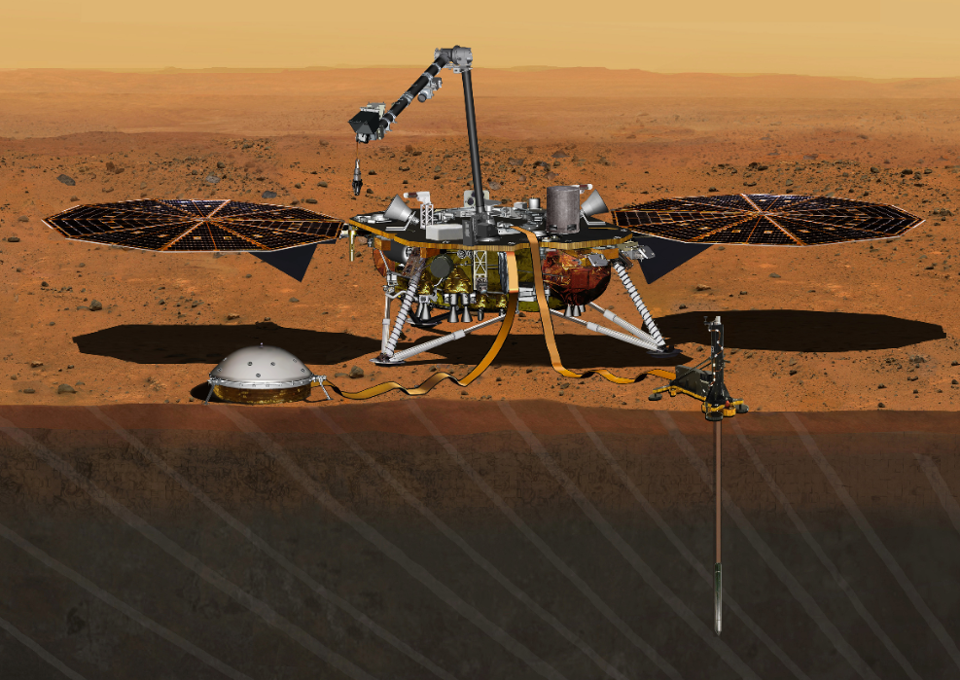Mars regained the world’s attention this fall, with recent news of the discovery of liquid water on the planet and a new blockbuster film set on Earth’s nearest neighbor, The Martian. This is a timely moment to focus on Red Planet Day, November 28.
Celebrate the fourth planet from our solar system’s sun with our series of blogs discussing general information about Mars, some of the more than 40 space missions humans have launched to study the planet, a section on the future of Mars and plans for manned missions to the planet, and concluding with links to fiction and non-fiction on Mars.
From Mars Hill near Flagstaff, the location of the main facility of Lowell Observatory where Pluto was discovered, to the Lunar Planetary Laboratory (LPL) at the University of Arizona in Tucson and Kitt Peak, which houses a massive collection of diverse astronomical instruments, our state has a long storied history in astronomy and with the Red Planet. UA’s LPL has been involved with the Mars Odyssey Orbiter, Phoenix Mars Lander, Mars Polar Lander, Mars Observer, Viking, HiRISE and Mars Reconnaissance Observer, Mars Global Surveyor, Mars Express, Mars Pathfinder, Beagle 2, Mars Exploration Rovers, and MAVEN missions to our crimson neighbor among many other lunar, planetary, and solar missions to study our solar system and the galaxies beyond.
In this pioneering, exploratory spirit, Heritage Elementary School, your Williams charter school, has paired with the other campuses in our district to put together a retrospective on 50 years of successful exploration on Mars for you to enjoy with your child and commemorate Red Planet Day. You can also enjoy the word search created especially for this topic.
Next Generation Exploration
The search for information about the Red Planet and answers to science’s questions about our smaller neighbor is still under way. The scientific community is moving closer to concrete answers about habitability, signs of life, and preparation for human exploration in the future.
NASA’s InSight in 2016
Next spring, NASA will launch a mission built using heritage technology, meaning that the scientists and engineers are using the same delivery system, programming, personnel, and landing vehicle which were part of the successful Phoenix mission. This lander, InSight (Interior Exploration using Seismic Investigations, Geodesy, and Heat Transport), is part of the NASA Discovery Program. Its scientific goals are to measure the vital signs and heartbeat of Mars through seismic devices which will allow scientists to better understand the way Mars’ interior works. It will use a heat flow probe to measure the thermal flux, heat coming from the interior of the planet. These two instruments will be placed on and inserted into the planet’s surface and left there. Another instrument, on the lander itself, will measure the rotation and “wobble” of Mars in an effort to better understand its core. Scientists are hoping not only to glean information usable for future missions, including manned missions, but to learn about early planet formation and the planetary process since Mars has not undergone the kinds of geological changes that larger terrestrial planets have. The 4th planet may hold answers and give new insight into the evolution of planets in our solar system and beyond.
ESA’s 2016 & 2018 Missions
The next mission, ExoMars Trace Gas Orbiter (TGO) and Schiaparelli Mission, is being led by the European Space Agency (ESA). It consists of an orbiter and a test lander. The TGO will be studying the Martian atmosphere for signature gases and gases of biological importance. Additionally, it will investigate the locations and sources of such gases. This multi-national mission will seek signs of life on Mars now and in the past, as well as investigating the Martian atmosphere and variations in the water and geochemical environment. NASA is participating in this operation and providing the Electra telecommunication radios successfully used on MRO. Electra uses UHF radios to not only return data to Earth, but to navigate and command the orbiter; this system also allows rovers, orbiters, and other spacecraft using the same system to communicate with one another. Electra assists with precision navigation via Doppler data.
The 2018 ExoMars rover, with its next-generation Pasteur scientific payload and the capability to drill 2 m (approximately 6 feet), will allow the study of ancient Martian rocks and deposits for possible signs of life, water, and other geochemical processes. The mission plan intends to land the rover in a location with a high potential to hold well-preserved organic material and will study subsurface samples for biomarkers.
Mars 2020
This NASA rover mission will use technology similar to Curiosity. The Mars 2020 project will, like previous missions, study past and present life on the planet. It will also characterize the Martian climate and geology, while preparing for human exploration—one of the four Mars exploration science goals. This rover will study the ancient environment of the planet within a field exploration area, determining geologic diversity, and look for biosignatures. It will also cache samples for a later potential return to Earth in future missions.
There is hope that this exercise will fill a Strategic Knowledge Gap (SKG) for human exploration, including measuring surface weather in order to validate global models. It will study the dust in the Martian atmosphere in the hope of understanding how it might affect human health and the surface systems on Mars. One of the top priorities is human habitability and testing the In-Situ Resource Utilization (ISRU) technologies. These could enable propellants and consumable oxygen to be produced from the Martian atmosphere, a vital facet in future exploration efforts, including manned missions.



